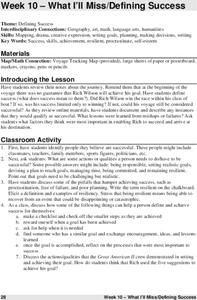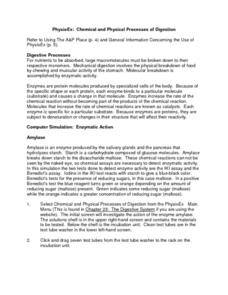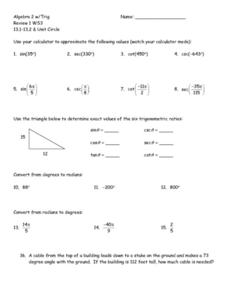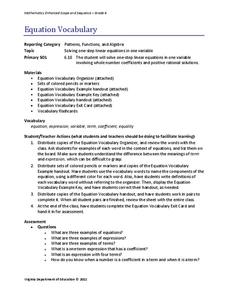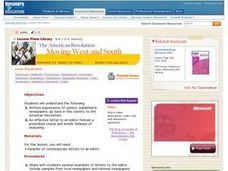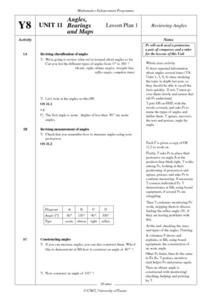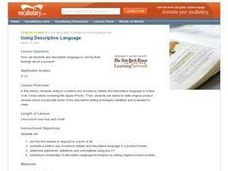Curated OER
Defining Success
The class defines what it means to be successful by examining the achievements of Rich Wilson. They create headlines for a mock paper, discuss achieving personal goals, and create a scrapbook of his journey. Tip: Use this resource when...
Curated OER
Adding and Subtracting Integers
Middle schoolers use discs in order to add and subtract integers. There are manipulatives present so kinesthetic learners can access the curriculum. They also review the concept of the opposite of positive and negative numbers.
Curated OER
Cyber Bullying
Cyber bullying is an important topic to address with middleschoolers. Here, learners take an active role in identifying and discussing this issue. Reviewing this resource with your class will help to equip them to be a part of the...
Edgate
Why Map a Map?
After brainstorming reasons why Native Americans mapped their lands, your young critical thinkers will work together to review their ideas and determine the definition of a map. With today's extensive use of mapping technology and GPS...
Curated OER
PhysioEx: Chemical and Physical Processes of Digestion
In this anatomy worksheet, students complete 22 review questions in the format of short answer, table completion, and fill in the blank after finishing an online virtual experiment about the chemical and physical processes of digestion.
Curated OER
Astronomy
A broad sampling of material related to stars is covered here. You will want to review each question to see if it corresponds to your curriculum. The formatting is inconsistent, but easily corrected if you use the information to create...
Curated OER
Matrix Operations
Here is a worksheet to practice or review basic matrix operations of addition, subtraction, and scalar multiplication. First, define and discuss key vocabulary terms, then have individuals work five simple problems. There are detailed...
Curated OER
Puzzled?
First graders practice identifying simple geometric shapes. As a class, they discuss positional words and review the words for simple shapes and their characteristics. They work together to create their own puzzle using the shapes.
Curated OER
Maps
First graders look at their classroom or school setting. They use positional word to describe where things are located in the school. Students discuss a map and why they are important. They read the story "Taylor's New School" and...
Curated OER
When Students Don't Clique
Students explore the roles of cliques in schools and ways in which schools can foster tolerance among diverse groups by reading and discussing "Alma Maters: Two Words Behind the Massacre."
Curated OER
Identifying Ordinal Position To Twentieth
Third graders investigate the concept of putting ordinal numbers in order from one to twenty. They work in a group to hold cards with a number and then line up in numerical order. Then students recognize the number and play a game with...
Curated OER
Review 13.1-13.2: Unit Circle
In this unit circle worksheet, students find the sine, cosine, tangent, cotangent, and co-secant of given values. They determine the exact value of trigonometric ratios. Students convert from degrees to radians. This two-page worksheet...
Curated OER
Women's History Month--Susan B. Anthony Question Review
This writing worksheet instructs students to read a short paragraph about Susan B. Anthony, then write 5 questions to 5 answers. This worksheet would be quite useful when teaching students about sentence structure, and different types of...
Curated OER
Introductory Algebra Chapter 1 Review
In this math worksheet, middle schoolers solve the problems that involve linear equations. They substitute the values given for each variable.
Virginia Department of Education
Equation Vocabulary
You'd feel bad if someone called you by the wrong name — and equations are no different. Young mathematicians learn the vocabulary associated with equations and expressions identifying these components in sample equations.
Curated OER
Further Improvements of Writing Skills
Improve writing skills by finding a personal writing style, using descriptive language effectively, and using precise language. Middle schoolers discuss individual style in writing and formal and informal language. They utilize figures...
EngageNY
Stretching and Shrinking Graphs of Functions
Why is that graph wider? Pupils learn about stretching and shrinking graphs of square root, absolute value, cubic, and quadratic functions. They study both vertical and horizontal stretches and shrinks in addition to reflections.
Curated OER
Recorder Ensemble
Third graders listen to and identify the lines and space of the treble staff and demonstrate how to sight-read to play the recorder. They answer comprehension questions regarding letter names of the musical alphabet and left and right...
Curated OER
Essay Exchange Unit: Final Drafts
Young scholars develop final versions of their position papers and add them to the school's web pages for review and feedback.
Curated OER
The American Revolution: Moving West and South
Students examine several letters to the editor from both a local newspaper and national newspapers. After reviewing current letters, they write a letter to the editor of an 18th-century newspaper expressing their opinion about the...
Curated OER
Angles, Bearings and Maps
Young scholars review what they comprehend about angles. They name the differnt types of angles and define them. Students use their protractors to answer questions, the teacher walks around to look at the positioning of the...
Curated OER
Using Descriptive Language
Students examine the use of adjectives in a product review, then write their own descriptive review. In this writing and word usage instructional activity, students first analyze the choice of adjectives in a New York Times article about...
Curated OER
Biotic and Abiotic Factors
In this biotic and abiotic factors worksheet, students complete 20 various types of questions related to biotic and abiotic factors. First, they write the vocabulary word that best completes the sentence. Then, students state an example...
Curated OER
Getting along With Others
Students examine character traits to find the most positive behaviors. In this getting along instructional activity, students identify behaviors that are beneficial to getting along. Students evaluate their own behaviors and...
